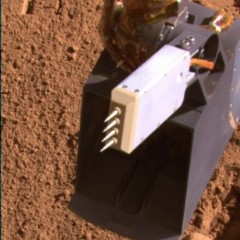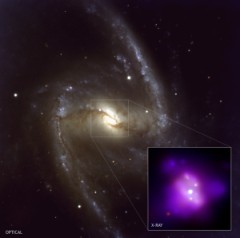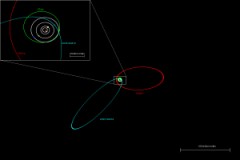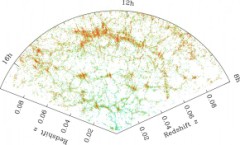|
It has been a while since our last astronomy news update and many a discovery has been made in interim. Of course there is an update on the Phoenix Lander that is revealing ever more mysteries on the Martian surface and bringing never before images of Martian clouds. As well new studies put an upper limit on the size of black holes, research has shown that all the dwarf galaxies around our own Milky Way appear to have the same mass (regardless of luminosity), a new minor-planet has been found inside the orbit of Neptune, the SDSS survey has discovered that there appears to be no dark matter in the cosmic voids found in the large scale structure of the Universe, and a recent Hubble image has shed some light on extra-galactic magnetic fields. All that and a little more in this edition of the cosmic wire…..
 | The instrument onboard Phoenix that tests
the electrical conductivity of the soil.
Credit: NASA/JPL-caltech/University of Arizo-
na/Texas A&M University |
Phoenix Update:
The Phoenix craft had dominated the headlines of most local and national newscasts, but as is usual it soon faded from the front pages, but that doesn’t speak to importance of the data and images being returned from the Martian polar frontier, for they have only increased in measure as of late. So the Lander has given us incredible images of ice in the Martian artic, and now it has given us images of clouds lazily floating above the latest robotic outpost on the red planet. The images are striking not for their alien aesthetic, but rather for the lack of it, for they look very much like something you would see on our own planet. As well the Lander has been hard at work conducting test on the Martian soil to try and determine the amount of water locked inside and just how much water is being cycled from the surface to the atmosphere and vice-versa, one of the instruments onboard (it looks like a robot fork) is used to test the electrical conductivity of the soil around the Lander site and what it found is most curious, it found nothing….zip…..nadda and that is most intriguing because other instruments show that there is minimal amount of water in the atmosphere and it was thought this would condensate in the evening and sublimate in the morning, meaning that the instrument should find some, though little was expected, electrical conductivity. All this will be figured out in due time of course and we will just have to wait and see what happens. There are also images just released of clumps of material adhering to the leg struts on the craft, ones that have been growing and were not seen there previously. There are several theories as to what the material is, could be ice, or mud, or salt, or…..well you get the idea, they haven’t exactly figured that one out either but give them time and they will. With Phoenix there is a steady trickle of information going out to the public but the major discoveries don’t happen every day, but that certainly doesn’t mean they won’t, and in fact Phoenix has already returned invaluable data from the Martian wilderness. So stay tuned for more on this most exciting mission. For more information visit the Phoenix Lander’s website at the following link; http://phoenix.lpl.arizona.edu/ Black Hole Upper Mass Limit:
Once objects only thought to exist theoretically, black holes are now a main stay of astronomy and astrophysics, as well as popular culture, with  | Image taken using opitical and x-ray tele-
scopes of the galaxy NGC 1365, showing
a cloud of gas that has eclipsed the central
super-massive black hole. The small box
shows the x-ray source from the center of
the galaxy.
Credit: X-ray:NASA/CXC/CfA/NAF/Risaliti
optical: ESA/ULT |
research having shown that nearly every galaxy has a massive black hole at its center, but there are still many unanswered questions about these cosmic monsters, like just how massive can they get. Two Yale astronomers, Priyamvada Natarajan and Eziquiel Treister, have been conducting research to answer that very question, and by observing many black holes at the core of the biggest elliptical galaxies have come to a conclusion. The upper mass limit on these “ultra-massive” black holes appears to be about 10 billion solar masses, which is breathtakingly massive and an answer that many were not expecting. The study shows that around such a mass the black holes seem to interrupt their own growth, no matter the epoch in which we find them and so this begs the question of why there is this limit. Well the Yale astronomers have a theoretical answer for us, according to them when the “ultra-massive” black holes reach 10 billion times the mass of the Sun they begin to radiate huge amounts of energy from their food supply and this causes the supply of dust and gas to be interrupted, shutting down the accumulation of mass for them. Though this is only a theoretical suggestion and much more research needs to be done, the discovery is none the less an important contribution to our knowledge of our Universe.To read more and see our original source visit the following link;
http://opa.yale.edu/news/article.aspx?id=5984
Stars or Not, They Seem the Same:
If you live or have ever been to the southern hemisphere than you might have turned you eyes skyward and seen the striking Magellanic clouds, dwarf galaxies that lay very close to our own Milky Way and the two Magellanic clouds are only a few of the more than twenty orbiting our galaxy. Research into these dwarfs has revealed some startling data. One would think that the more luminous dwarfs, the ones with more stars, would be larger in terms of mass but new research indicates other wise.  | A map showing the local group, of which
the Milky Way is a part. |
And what is the reason for this conclusion, dark matter, what else. The study has shown that regardless of the luminosity the dwarfs all share the same approximant mass, around 10 million solar masses and studies on the nature of dark matter have shown that the minimum mass for dark matter that will allow for stars to form into galaxies is around the 10 million solar masses found in the masses of so many Milky Way satellites. So the research is saying that some of the small satellites could very well be dark matter dominated in terms of the their mass (within a 300 parsec central region). Though no formal conclusions have been reached in the mystery of the mass scale of these small galaxies the research will go on and could give us yet more insight into that mysterious and enigmatic stuff; dark matter. For more information on this study please visit the following site and our original source; http://arxiv.org/abs/0808.3772 New Minor Planet:
The Sloan Digital Sky Survey has been up and running for a while now, returning data on vast amounts of objects in the deep sky, from galaxies to quasars to supernovae and now the team working on the survey have announced that they have found a previously unknown dwarf planet inside  | Rendering of the orbit of the newly found
minor planet.
Credit: N. Kaib/SDSS |
the orbit of Neptune. The object, dubbed, 2006 SQ372 is believed to be a small icy body, around 50-100km across that was only found because it is on its closest approach to the Sun. The objects orbit takes it on a 22,500 year pathway that extends, at its greatest length, 150 billion miles from the Sun, which is an amazing distance. So where did this newly found object come from? Well that is, of course, still in debate, some think it could have formed, like Pluto, in the fields of icy bodies beyond Neptune and arrived in its current orbit because of gravitational interactions with larger bodies, but others think that it could be a lone traveler from the Oort cloud. The Oort cloud is believed to be a massive cloud of objects and debris from far, far beyond the orbit of Neptune, really far beyond, for even when SQ372 is at its furthest point in its orbit; it will still be some 10 times closer to the Sun than the Oort cloud. So the origin of this body will be debated for some time to come, but it none the less adds yet another body to the growing list of newly found objects and could get us closer to understanding the nature and workings of our own solar system. For more information on this amazing find please visit the following link and our original source;
http://www.sciencedaily.com/releases/2008/08/080819085858.htm
And for a diagram of its orbit visit the following link;
http://ssd.jpl.nasa.gov/sbdb.cgi?orb=1;sstr=2006+SQ372;view=Far
No Dark Matter in Cosmic Voids:
When one looks at the large scale views of the Universe certain structures emerge in the picture, where massive clusters of galaxies form what are called filaments and voids. The filaments are vast tracts of galaxy clusters and super clusters stretching out for millions of light years like a cosmic web, in between those filaments are the voids, which are nearly empty spaces stretching for millions of light years themselves. This structure has been thought to have been seeded in the very early Universe, having been pulled together over time by the slow workings of gravity into the web that we  | Map showing largescale distribution of
galaxies and their corresponding red-shifts.
Credit: M.Blanton and the SDSS |
see today. For a while there were questions on just how empty these voids really are, well recent studies done using data collected by the Sloan Digital Sky Survey has begun to answer that question, and what is emerging is that the voids really are almost totally empty. Using models made possible from the ‘standard’ theory of cosmology the observations from the survey were compared with the predictions of the model and viola, they match, almost spot on. The observations showed voids as large as 75 million light years across and this is on par with what the ‘standard’ model predicts, and they are not only devoid of normal matter (the stuff that reacts with light and that we are made out of) they are also lacking any dark matter and this is noteworthy find. In fact it is the dark matter that engenders the structure seen in the cosmos, not the way we find it today but the way it was distributed in the very early (primordial) universe. Over time gravity pulled the dark matter into larger structures thus allowing the normal (baryonic) matter to fall into the already condensed clumps of dark matter. This is what allowed for galaxy formation and ultimately the largest structures of super clusters of galaxies. This research is not only very interesting but very important for determining the validity of models of the universe like the ‘standard’ cosmological model, and the best part is that its ability to explain has only been enhanced by actual observation. For more information on this story and to read our original source follow the link given below; http://www.sdss.org/news/releases/20080817.vpf_final.html “The Magnetic Monster”:
The Hubble seems to never cease delivering to us marvelous pictures from the final frontier, and one of its latest has helped to further understand the nature of what are called ‘extra-galactic’ magnetic fields. These super-large magnetic structures are found in the largest of the galaxies observed, elliptical, that hide at their core super-massive black holes that interact with the gas found of the galaxy cluster in which they are located,  | Hubble image of the magnetic filaments
in NGC 1275.
Credit: NASA/ESA/ Z. Levay (STScI) |
causing strange, massive filaments of hot gas to stretch out into the cluster gas. Most of these filaments are to far away to be imaged in great resolution, but one galaxy, NGC 1275 is close enough that the Hubble space telescope was able to image the ethereal filaments and the data that has been returned from the imaging is shedding more light on a mystery of these beautiful extra-galactic structures. Astronomers have long wondered why these threads of hot, x-ray emitting gas didn’t just collapse under their own mass to form new stars and clusters, now they have a better grip on why these structures stick around. The size of the threads is amazing, at least in terms of our own perspective of size, for they average around 200 light-years wide, about 20,000 light-years long and have the mass of around one million times that of our Sun (and that is just the average size!). They key to these structures keeping themselves together is the magnetic fields that run through them, they are strong enough to resist gravitational collapse and dispersion from other pressures, and where do these magnetic fields come from? Well they are in the end tied back to the central black hole deep in the core of this behemoth of a galaxy, which helps to explain the unique relationship that super-massive galactic core black holes have to their own galaxy, the surrounding cluster and its gas. To read more on this and see other information gathered by the Hubble space telescope visit the following link and our original source;http://hubblesite.org/newscenter/archive/releases/2008/28/full/ |

